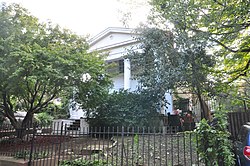Lefferts-Laidlaw House
|
Lefferts-Laidlaw House
|
|

September 2012
|
|
| Location | 136 Clinton Ave., Brooklyn, New York |
|---|---|
| Coordinates | 40°41′38″N 73°58′09″W / 40.69389°N 73.96917°WCoordinates: 40°41′38″N 73°58′09″W / 40.69389°N 73.96917°W |
| Area | less than one acre |
| Built | 1840 |
| Architect | Lefferts, Rem; Laidlaw, John |
| Architectural style | Greek Revival |
| NRHP reference # | |
| Significant dates | |
| Added to NRHP | September 12, 1985 |
| Designated NYCL | November 13, 2001 |
Lefferts-Laidlaw House is a historic villa located in Wallabout, Brooklyn, New York, New York built about 1840 and is a two-story frame building in the temple-fronted Greek Revival style.
The house site was originally part of a 100 feet wide by 246 feet deep tract of land purchased in 1834 by Henry Ryer, a Manhattan merchant, from George Washington Pine. Ryer divided the property, located on the west side of Clinton Avenue (named in honor of New York Governor DeWitt Clinton.) into four 25 feet wide lots.
After a few sales and repurchases, the land was bought by Rem Lefferts, a Brooklyn merchant, and his brother-in-law John Laidlaw. The main portion of the house was built about 1840. A two-room wing that was only one story was likely built between 1836 and 1840 between the main portion of the house and the rear kitchen. The first residents were Leffert Lefferts, Jr. (1791-1868), Rem's older brother, and Amelia Ann Cozine Lefferts (1782-1878), daughter of Margaret Roosevelt (granddaughter of Johannes Roosevelt) and John Cozine (d. 1796), a New York attorney and judge of the New York State Supreme Court. Lefferts was the oldest child of Sarah Cowenhoven (1775-1856) and John L. Lefferts (1763-1812), brother of Leffert Lefferts.
In November 1843, Lefferts sold the property to his sister, Sarah Lefferts Millard (1805-1849), and brother-in-law, A. Orville Millard (b. 1809). Millard was a native of Ulster County and moved to New York City in 1830 to study law, opening an office on Nassau Street in Manhattan. In 1849, Sarah Millard died following the birth of her sixth child. Millard owned the home until it was purchased by real estate investor Robert Bage in April 1854.
The house is a two-story frame building in the temple-fronted Greek Revival style. It consists of a two-story central section with a one-story south elevation and two-story rear extension. The front facade features a gabled portico supported by four Corinthian fluted columns with an iconic entablature and pediment.
...
Wikipedia



